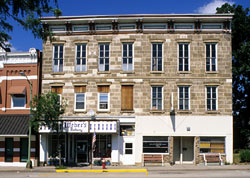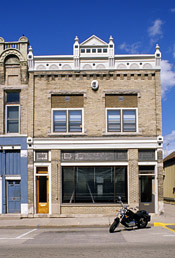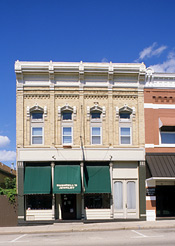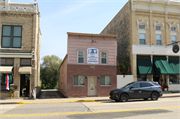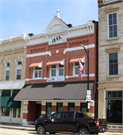133, 137-39, 143, 147, 157 and 161-165 South Main Street
| Historic Name: | Lodi Downtown Historic District |
|---|---|
| Reference Number: | 08000980 |
| Location (Address): | 133, 137-39, 143, 147, 157 and 161-165 South Main Street |
|---|---|
| County: | Columbia |
| City/Village: | Lodi |
| Township: |
| Lodi Downtown Historic District 133-165 (odd) S. Main Street, Lodi, Columbia County Construction dates of contributing buildings: 1866-1895 Isaac H. Palmer founded the city of Lodi in 1846. He chose the site because it was beautiful and because Spring Creek, which runs behind and through the city's historic commercial district, offered excellent opportunities for harnessing water power for milling. By 1850, the new community could boast of having a saw mill, a grist mill, and a flouring mill and it was the placement of these three mills (all now non-extant) in close proximity to one another on the banks of Spring Creek that first defined where the business core of the village would eventually develop. These mills were so important to the surrounding area that Lodi was already established as the commercial center for the surrounding farms by the time the first railroad arrived in 1871. The six buildings that make up the Lodi Downtown Historic District include the oldest surviving building associated with commerce in the city. This the left half of the J. O. Eaton Building (161-165 S. Main St.), built in 1866 next door to Eaton's own home, which is now a house museum operated by the Lodi Valley Historical Society. Eaton's three-story, limestone-clad, Italianate style building continues to be the tallest commercial building in Lodi. After he completed the right half of the building in the bicentennial year of 1876, it was also the community's largest building. By the 1880s, Lodi's small, original, wooden commercial buildings, such as the Boomtown style Charles G. Cummings building (143 S. Main St.), were being replaced by larger, more substantial (and fire resistant) ones of brick. Two of the best of these are both located in the district and were designed by a carpenter/architect named E. M. Hackett, who lived in Reedsburg, Wisconsin: the Italianate style J. Frank Collins Building (147 S. Main St.), built in 1883; and the Commercial Vernacular form Joel M. Pruyn Building (157 S. Main St.), built in 1885. Two more excellent examples were also built in the district in the following decade: the Commercial Vernacular form Schmiedlin Bros. Building (133 S. Main St.), built in 1895; and the Commercial Vernacular form Bank of Lodi Building (137-39 S. Main St.), which was built next door in the same year. The buildings continue to house local businesses. Please respects the rights and privacy of the occupants.
|
| Period of Significance: | 1866-1958 |
|---|---|
| Area of Significance: | Architecture |
| Area of Significance: | Commerce |
| Applicable Criteria: | Architecture/Engineering |
| Applicable Criteria: | Event |
| Historic Use: | Commerce/Trade: Specialty Store |
| Historic Use: | Commerce/Trade: Financial Institution |
| Architectural Style: | Late Victorian |
| Resource Type: | District |
| Architect: | Hackett, E.M. |
| Historic Status: | Listed in the State Register |
|---|---|
| Historic Status: | Determined Eligible/Owner Objection |
| Historic Status: | Listed in the National Register |
| National Register Listing Date: | 04/11/2014 |
| State Register Listing Date: | 01/18/2008 |
| Number of Contributing Buildings: | 6 |
|---|---|
| Number of Contributing Sites: | 0 |
| Number of Contributing Structures: | 0 |
| Number of Contributing Objects: | 0 |
| Number of Non-Contributing Buildings: | 0 |
| Number of Non-Contributing Sites: | 0 |
| Number of Non-Contributing Structures: | 0 |
| Number of Non-Contributing Objects: | 0 |
| National Register and State Register of Historic Places, State Historic Preservation Office, Wisconsin Historical Society, Madison, Wisconsin |

